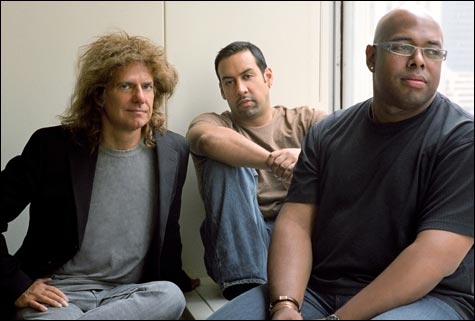
METHENY AND FRIENDS: “It’s a pretty dense-sounding band for three guys.”
|
Now 53 and more than 30 years into a remarkable career, Pat Metheny still approaches jazz like a kid let loose in a candy store. But the sweets aren’t all those racks of guitars that surround him on stage. (They include his custom-designed 42-string “Pikasso” guitar, his godawful synth guitar, and any number of other goodies.) It’s the people he finds to play with.
“One night I’d wake up and say, ‘Wow, those two guys have never played together — what would that be like?’ ” Metheny is calling from the road, where he’s working with his latest trio mates, bassist Christian McBride and drummer Antonio Sanchez, following the release of their debut CD, Day Trip (Nonesuch); they come to the Somerville Theatre for two shows this Sunday. Each of the trios Metheny has put together over the course of his career has been, in its own way, a classic: his debut-CD band with Jaco Pastorius and Bob Moses; the Ornette-inspired sessions with Charlie Haden and Billy Higgins; the über-bebop band with Dave Holland and Roy Haynes; the next-wave jazz with Larry Grenadier and Bill Stewart.
The current trio, first assembled in 2002, is something else again. “The first time I heard Christian was at the Regattabar, and he was 16 or 17, playing with Freddie Hubbard, and of course right away it was, like, ‘This guy can really play!’ But what really struck me about him was that he sounded like Wes Montgomery — it was this melodic thing, and really great ideas.” Metheny says that “this melodic thing” in improvisation is what he finds most elusive in his travels as “a fan of music. . . . It’s the hardest thing even to discuss — why is it that I hear it in Christian when I don’t hear it in X, Y, or Z? I don’t even know if I can describe it, but it’s the way ideas go from one to the next that adds up to more than any one of them.” It doesn’t hurt, Metheny continues, that “he’s an amazing guy, he’s a beautiful guy, and everybody who knows Christian knows that.”
Metheny and McBride had worked together in any number of situations, notably with Joshua Redman, but the idea of a trio was long-simmering. Meanwhile, Metheny had discovered Sanchez, who is also a member of the long-running Pat Metheny Group. “My first impression of Antonio was how great he could play soft. I heard him playing a ballad with Danilo Pérez and I was like, ‘Wow, how many people can play that soft and that burning?’ ” Hanging backstage a few tunes later, “I heard what I thought was 16 people playing, and I thought Danilo must have added a percussion section, but it was still just this one guy.”
Metheny describes playing with Sanchez as “life-changing — he fits so many things that I’m interested in.” In particular, Sanchez has been a boon for the PMG, whose requirements of a drummer are especially demanding — “almost weird,” says Metheny — in that the percussionist is asked to navigate and cue complex charts of sometimes dense orchestral material for large ensemble, traverse jazz, funk, Afro-Latin, and rock rhythms, and also excel as an improviser.
The current trio, says Metheny, has stretched each player out of his comfort zone. “It isn’t a no-brainer. It was good from the very first gig, but it’s also taken time, and I wanted to take that time. We’ve all had to make room for each other. And we all play a lot of stuff — it’s a pretty dense-sounding band for three guys.”
This is the first Metheny trio album to be built entirely of his own compositions — written over time to play to the band’s strengths, some pieces tried and discarded. In that sense, it might be the most “Metheny-like” of his trio albums — favoring folk-pop lyricism even as it flies through odd meters and daunting harmonic shifts. He exploits McBride’s melodic gift — Montgomery guitar-like pizzicato solos on the ballad-tempo “Dreaming Trees” and “At Last You’re Here,” and the bowed refrain on the Katrina meditation “Is This America?” Sanchez, meanwhile, is everywhere, “burning” softly with his brushwork on the ballads, shifting from rock to reggae on “The Red One,” playing cymbals and skins in cross-rhythms, like different voices in a chorus — not 16 players, maybe, but at least two or three.
The tunes vary from the shuffle swing inspired by the famous Kansas City organ-trio guitarist of Metheny’s Missouri youth, Calvin Keys, to the edgy 6/8 workout of “When We Were Free,” those folk-pop reveries, and the unabashed power chords of “The Red One.” “Is This America?” is more mournful than angry, acoustic rather than electric, and it favors a quiet country shuffle rather than a NOLA second line. It sounds almost like a basic I-IV-V progression. “It’s a little more than that — basically it’s the same melody with three different sets of chords for the three A sections and the B section functioning as a bridge.” The piece emerged as the band were touring and watching nightly news footage. “It’s rare for me that there’s a literal response to something, an A/B correlation, but that time there was. I agree, it’s not an angry statement, it’s just a question: is that it? Is that really where we are right now? And, sadly, in this time I think the answer speaks for itself.”